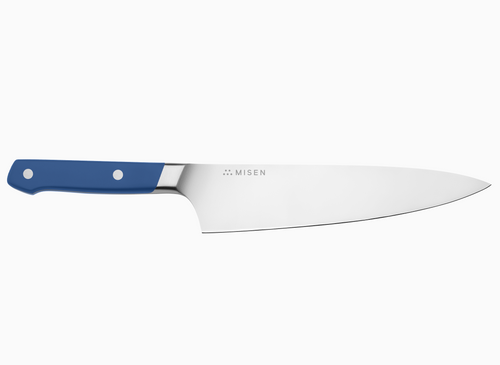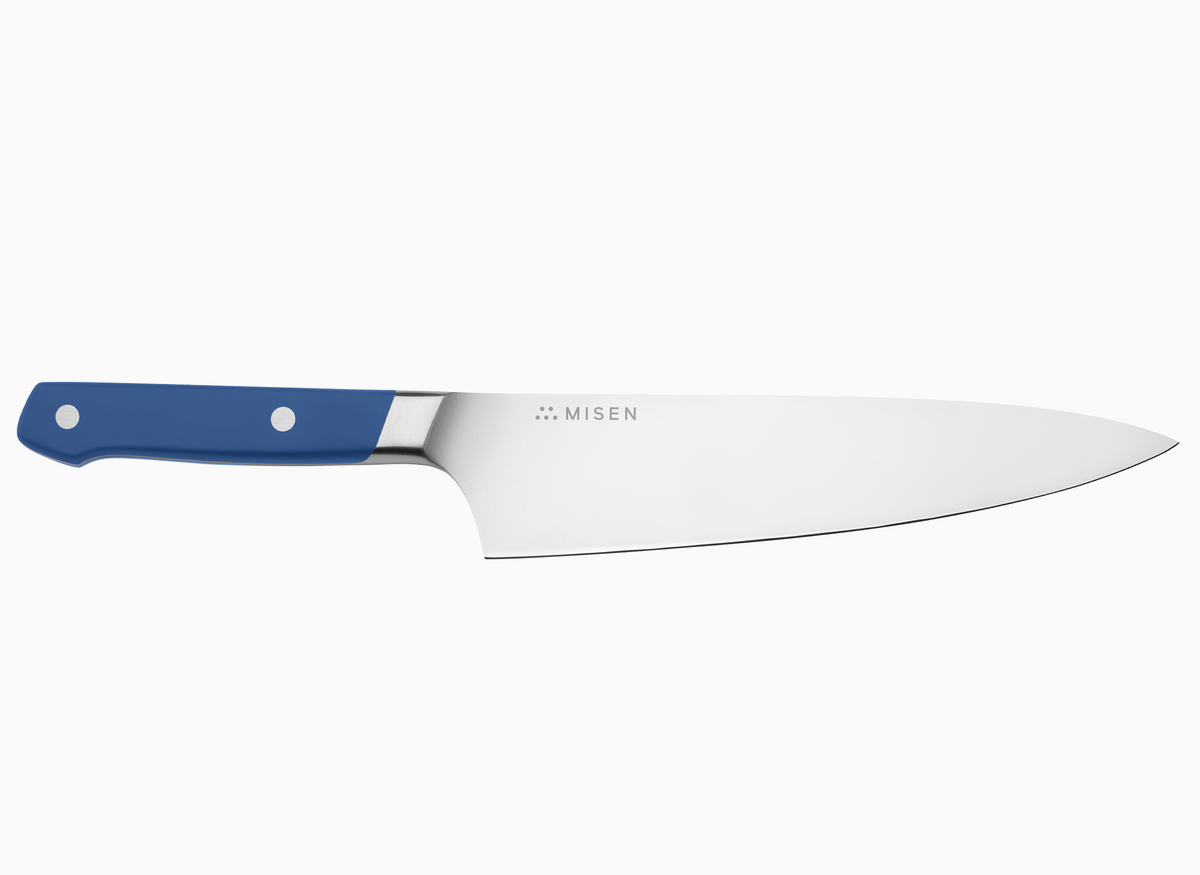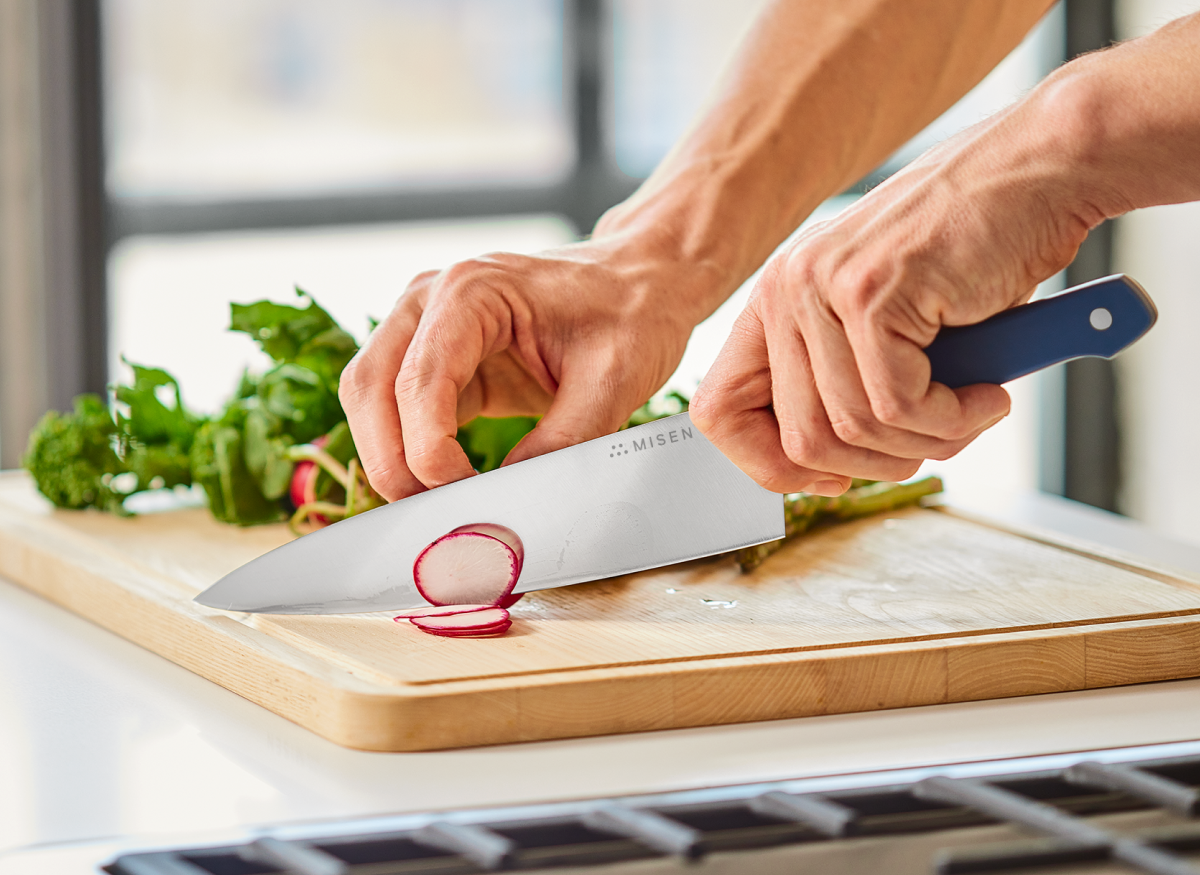How to Use a Sharpening Stone to Make Your Knives as Good as New
 Knives should be sharpened once or twice a year to create a new edge.
Knives should be sharpened once or twice a year to create a new edge.
- A knife’s sharp edge is best maintained through a process of honing and sharpening.
- Honing should be done daily or at least once a week, while sharpening is recommended once or twice a year.
- The three types of sharpening stones are oil stones, water stones, and diamond stones.
Compared to how far kitchen knives have come from their chiseled flint days (sleeker, stronger, more ergonomic), the tools used to sharpen them have not seen nearly as much change.
Honing steel and sharpening stones, the most common knife sharpeners, are just that — steel rods and coarse “stones” (or rather, rectangular blocks). Simple, but still the most effective tools.
Through the years, their original design and rugged material have proven to keep a knife’s cutting edge in great shape and ably accommodate all your sharpening needs.
Honing and Sharpening
It’s common to confuse honing with sharpening. While they both help to maintain a knife’s sharp edge, they each have a specific time and place in cutlery upkeep.
The general idea is that you hone your knife with a honing steel when the blade is dull, and sharpen it with a sharpening stone when the blade is damaged.
Metal is inherently malleable. When faced with continuous chopping and cutting, a knife’s thin edge accumulates so many tiny dents it can easily get bent out of shape. So even if a blade is still sharp, it tends to feel dull.
Honing
Honing realigns a wayward blade back to its straight cutting edge. While no actual steel is removed, a well-honed knife will seem sharper because its steel edge been put back in the proper position — no more dents.
Honing can be done as often as you like — before or after each use is ideal, although once a week will do — as general maintenance.
But there’s only so much honing can do. Over time, when a knife gets a really dull edge, only a good knife sharpening session will get it back into shape.
Sharpening
Sharpening works by removing small bits of steel — the bits that don’t cut properly anymore — to create a sharp, new edge.
Because sharpening does shave off steel, it's important not to sharpen a blade too much or too frequently. Overdoing it can distort a knife’s original intended shape.
Sharpening is best kept to just once or twice a year, to create a cutting edge that feels as good as new.
What Is a Honing Steel
A honing steel is essentially a long rod with an abrasive surface used to realign blade edges. The three most common materials to make them are stainless steel, ceramic, and diamond-coated. Stainless steel is the most popular option, and a good middle ground in terms price. They come in a variety of forms, with a smooth or ridged texture, and square or round edges. Ceramic rods are harder than stainless steel and are great for knives made of harder steel. They are, however, a brittle material and can break if not properly handled. Diamond-coated steel is the roughest of the three, shaving off the most amount of steel and are better for periodic use.
The most crucial feature of honing steel, however, is length. The longer the steel, the more surface area to hone the knife on. One that's at least 12 inches — the measure of the rod itself, without the handle — should be able to hone most pieces of home cutlery.
How to Hone a Knife
 Honing does not actually sharpen knives, it realigns the blade back to its straight cutting edge.
Honing does not actually sharpen knives, it realigns the blade back to its straight cutting edge.
To properly hone a knife, all you need is your honing steel, the knife that needs honing, a non-slip, flat surface (cutting boards work well), and a dish towel.
Start by positioning the honing steel vertically in front of you with your non-dominant hand on the handle (thumb facing you) and the tip of the rod resting on the cutting board. The steel should stay in the same position the entire time.
Take the knife in your dominant hand, and place the sharp edge of the blade’s heel (the part closest to the handle) against the base of the honing steel. If you’re positioned correctly, the steel and the knife should be perpendicular and both your hands should be close to each other.
Angle the knife against the honing steel, about 15 degrees for Asian-style knives, and 20-degrees for Western-style knives. From this position, run the knife along the steel in a single motion, moving your dominant arm simultaneously downward and back toward you. This will allow the entire length of the blade to come in contact with the steel, from the heel to the tip of the knife. It should almost feel like you're making an exaggerated chop.
Maintain a light pressure throughout the movement. You’re aiming for a light metallic ring rather than a rough grind sound — that would mean you’re applying too much force.
Return the knife to its starting point, this time placing the other side of the blade against the opposite side of the honing steel. Repeat running the blade in a downward motion. Continue alternating, for about five to ten times per side.
When you’re done, wipe the blade with a towel to remove any steel residue. Test your handiwork by slicing through a piece of paper or ripe tomato. A well-honed blade should slice through cleanly.
What Is a Sharpening Stone
Sharpening stones come in a range of materials, shapes, and sizes. They are also referred to as “whetstones.” The word “whet” means “to sharpen.”
Sharpening stones are categorized by grit size, using numbers that correspond to the density of the particles. A lower number, about 220 or so, indicates a coarse grit that removes metal quickly and sharpens faster. Mid-ranges, from 1000 to 1500, are considered medium grit and are usually the best sharpening stone to use on dull knives. A higher number, from 4000 and above, indicates a fine stone grit with small particles.
It's best to buy a dual grit sharpening stone or a complete sharpening stone set, as each grit is useful for different purposes. For example, a coarse stone is good for bigger repair jobs or to start honing a heavily damaged blade; while a fine grit stone is perfect for finishing any knife sharpening session with a smooth polish.
The size of stone you want will depend on the size of the knives you plan to sharpen. Larger knives will need larger stones. In general, the average kitchen knife will need a stone that's about 7-8 inches in length, and about 1-2 inches in width.
Types of Sharpening Stones
There are three types of knife sharpening stones — oil stones, water stones, and diamond stones. These stones are actually flat, rectangular blocks, with each type having its own characteristics.
Sharpening stones are available in natural and synthetic materials. While natural stones were the original sharpening tools, they are less used these days, as synthetic options provide consistent grit and high quality.
Oil Stones
Oil stones are the most traditional and most common sharpening stones. They come in both natural materials (novaculite, also called Arkansas Stones) and synthetic materials (aluminum oxide or silicon carbide), and are graded as fine, medium, and coarse.
Oil stones are so called because you need to oil them before sharpening. Honing oils can be petroleum-based, such as mineral oils, or non-petroleum based, such as vegetable oils.
A good coat of oil can help reduce any friction between the stone and the blade, creating a more fluid movement while sharpening. Honing oil also serves a dual purpose of attracting all the removed metal (called swarf) and making the stone easy to wipe clean.
While oil stones perform well and are generally more affordable, they do cut at a slower rate as compared to all other stones.
Water Stones
 Sharpening stones are still one of the most popular and recommended ways to sharpen a kitchen knife.
Sharpening stones are still one of the most popular and recommended ways to sharpen a kitchen knife.
Water stones are relatively new, but already gaining traction among the cutlery community. The most popular type is aluminum oxide, although like oil stones, water stones are available in both natural and synthetic materials.
Water stones are comparatively softer than oil stones. While this does facilitate faster sharpening, a softer surface also wears down more quickly. If a stone becomes uneven, it will need to be flattened back to shape (using sandpaper or a flattening stone).
Water stones also need to be soaked in water for several minutes before use, or until the stone stops producing bubbles. This indicates that all the pores have been filled and allows the blade to glide smoothly over the stone’s surface. If this seems like a long time to wait before sharpening, there are also a few good splash-and-go sharpening stones that only need to be run under water for less than a minute before use.
Diamond Sharpening Stones
Diamond sharpening stones are not actually stones, but thin metal plates with micron-sized diamonds embedded into the surface. Diamond plates are harder and coarser than any natural or synthetic sharpening stone.
There are two types of diamond stones — perforated and non-perforated. Perforated is more popular, as the holes are useful in catching any swarf during the sharpening process. Non-perforated styles, on the other hand, have a continuous surface that is great for sharpening knives with any sharp points (i.e. paring knives) that may get caught in the holes.
Diamond stones are available in different grits from extra fine to extra coarse. They also come with either monocrystalline diamonds or polycrystalline diamonds with monocrystalline being the longer-lasting of the two.
While more expensive, diamond sharpening stones can sharpen knives very quickly and retain their shape more easily than other stones.
How to Sharpen a Knife
Although done only once or twice a year, knowing how to sharpen your knife is a handy kitchen skill and a good way to make sure your knives are in tip top shape.
Once you feel that regular honing is no longer keeping your cutlery sharp, it’s time to bring out your sharpening stone. A sharpening stone is the preferred way to sharpen blades, although an electric or manual knife sharpener will also do when you need something quick.
Sharpening Stone
Most sharpening stones need to be saturated in oil or water before use. Make sure to check and follow the manufacturer’s instructions.
Once your sharpening stone is ready, place it horizontally on a non-slip, flat surface. Some sharpening stones come with their own non-slip base (i.e., a bamboo base or plastic base), but a damp paper towel or fabric towel works just as well to hold the stone securely in place.
Using your dominant hand, hold the knife with the cutting edge facing away. Position the heel of the blade at one end of the stone, with the edge at a 15 degree angle for Asian-style knives or a 20 degree angle for Western-style knives. The knife should look like it’s about to rest on the sharpening stone.
Place the fingers of your non-dominant hand on the top side of the blade. Then, using both arms, simultaneously sweep the knife across and down the stone in a wide, semi-circle shape, almost as if you’re guiding the knife towards your hip. Apply an even pressure throughout the motion.
Release the blade at the end of the sweep, and return to the starting position. Do this for about 10 to 15 passes, or until you feel a slight burr (a small fold of metal) on the cutting edge of the knife. This indicates that one side of the blade is sufficiently sharp.
To sharpen the other side of the blade, flip the knife around so that the opposite side is now facing up and go through the motions again, this time in the opposite direction. Remember to use the same sharpening angle and number of passes.
Once both sides have been sharpened, you can repeat the sharpening process on a finer grit, or simply wipe the knife down and start slicing.
Knife Sharpeners
 Knife sharpeners are available in manual and electric models, and are built for more general purpose sharpening.
Knife sharpeners are available in manual and electric models, and are built for more general purpose sharpening.
Knife sharpeners are a comparatively modern gadget for those who need a quick and easy fix — just insert the knife blade into the slot and let the sharpener do the rest.
Available in manual and electric options, knife sharpeners are very simple to use. They basically work by pulling the blade through a slot, which has been lined with different grades of abrasive material, until the blade reaches desired sharpness.
The key difference between the two is that manual sharpeners have fixed abrasives, while electric knife sharpeners have abrasives on motorized wheels that spin against the blade.
Knife sharpeners are built for general purpose sharpening. Their fixed abrasives can be difficult to gauge and can’t give you the perfect polished knife edge you’re looking for. That said, they also may not work with some specific knives, such as knives with bolsters, large blades, or extensive damage.
Getting to the Point
There are many ways to keep your knives sharp, with honing steel and sharpening stones being the top methods. The two actually work best in tandem. Honing does the regular maintenance, and sharpening steps in for that infrequent, though very important, tune-up.
With just these two simple tools, you’ll be equipped to handle most kitchen knife conundrums, whether a tiny dent or a sizable nick.








